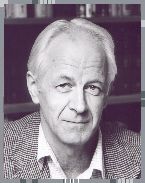
Allan C. Wilson
CASE STUDY IN MOLECULAR EVOLUTION NO.
3
Written by Harold B. White, Sept 1993,
revised 1995 & 1997
C-647 BIOCHEMICAL EVOLUTION, FALL 2000

Allan C. Wilson |
Allan C. Wilson (1934-1991), perhaps the foremost molecular evolutionist in recent time (1-3), never shied from controversy. His lifelong interest in natural history and biological evolution gave him the uncanny ability to identify the unresolved, controversial issues of phylogeny and evolutionary theory that he and his associates could address with modern biochemical techniques (4-18). Repeatedly he confronted biologists and anthropologists with data that challenged their cherished models. For his work he received a MacArthur Foundation fellowship, dubbed the "Genius Award" because the recipients are often outstanding but unconventional thinkers from diverse fields (19). He was a member of the American Academy of Arts and Sciences and the Royal Society of London. |
In the subsequent years Wilson and his coworkers continued to collect data to test the "Eve Hypothesis." They sequenced particular segments of mitochondrial DNA from over 200 individuals (23,24), and their conclusions remained consistent. In addition, another group using restriction mapping of mitochondrial DNA from 3065 humans also concluded that humans had a recent origin in Africa although they refused to set a date (25). Thus, in 1991 when Allan Wilson died while being treated for leukemia, there seemed to be consistency in the results and growing support for his conclusions (26).
Focus Questions for Initial Group Discussion (Tuesday, 26 September)
What are the characteristics of mitochondrial DNA? (Size, structure, proteins and RNA's encoded, mode of inheritance (47), unusual properties, etc.)
Make a reasonable estimate (based on a rationale that you can explain to other groups) how long it has been since all the people in your group had a common ancestor. We will share the estimates and their basis before the end of class.
What would you want to know (learning issues) in order to evaluate the claims of Wilson and his challengers? Make a list of at least ten specific questions.
References
1. Jukes, T. & Zuckerkandl,
E. (1991) "Remembering Allan Wilson," J. Mol. Evol. 33, ii.
2. Felsenstein, J. (1991)
"Allan Charles Wilson (1934-1991)" Nature 353, 19.
3. Gibbons, A. (1991) "Systematics
goes molecular" Science251,
872-874.
4. Wilson, A. C., Cahn,
R. D. & Kaplan, N. O. (1963) "Functions of the two forms of lactate
dehydrogenase in the breast muscle of birds" Nature 197,
331-334.
5. Kitto, G. B. & Wilson,
A. C. (1966) "Evolution of malate dehydrogenase in birds" Science153,
1408-1410.
6. Sarich, V. M. & Wilson,
A. C. (1967) "Immunological time scale for hominid evolution" Science158,
1200-1203.
7. Wallace D. G., Maxson,
L. R. & Wilson, A. C. (1971) "Albumen evolution in frogs: A test of
the evolutionary clock hypothesis" Proc.
Natl. Acad. Sci. USA 68, 3127-3129.
8. Wilson, A. C., Mason,
L. R. & Sarich, V. M. (1974) "Two types of molecular evolution. Evidence
from studies of interspecific hybridization"
Proc.
Natl. Acad. Sci.71, 2843-2847.
9. King, M-C. & Wilson,
A. C. (1975) "Evolution at two levels in humans and chimpanzees" Science188,
107-116 (see also commentary Science189,
446-447).
10. Wilson, A. C., Carlson,
S. S. & White, T. J. (1977) "Biochemical evolution" Ann. Rev. Biochem.
46,
573-639.
11. Cherry. L. M., Case,
S. M. & Wilson, A. C. (1978) "Frog perspective on the morphological
difference between humans and chimpanzees" Science200,
209-211.
12. Ferris, S. D., Brown,
W. M., Davidson, W. S. & Wilson, A. C. (1981) "Extensive polymorphism
in the mitochondrial DNA of apes" Proc.
Natl. Acad. Sci. USA 78, 6319-6323.
13. Brown, W. M., Prager,
E. M., Wang, A. & Wilson, A. C. (1982) "Mitochondrial DNA sequences
of primates: Tempo and mode of evolution"
J.
Mol. Evol. 18, 225-239.
14. Beverley, S. M. &
Wilson, A. C. (1985) "Ancient origin for Hawaiian Drosophilinae inferred
from protein comparisons" Proc.
Natl. Acad. Sci. USA 82, 4753-4757.
15. Stewart, C-B., Shilling,
J. W. & Wilson, A. C. (1987) "Adaptive evolution in the stomach lysozymes
of foregut fermenters" Nature 330, 401-404 (commentary Nature330,
315).
16. Pääbo, S.,
Gifford, J. A. & Wilson, A. C. (1988) "Mitochondrial DNA sequences
from a 7000-year-old brain" Nuc.
Acid Res. 16, 9775-9787.
17. Prager, E. & Wilson,
A. C. (1988) "Ancient origin of lactalbumin from lysozyme: Analysis of
DNA and amino acid sequences" J.
Mol. Evol.
27, 326-335.
18. Pääbo, S.,
Higuchi, R. G. & Wilson, A. C. (1989) "Ancient DNA and the polymerase
chain reaction" J.
Biol. Chem. 264, 9709-9712.
19. Brown, M. H. (1990)
The
Search for Eve, 357 pp, Harper & Row, Publishers, New York.
20. Cann, R. L., Stoneking,
M. & Wilson, A. C. (1987) "Mitochondrial DNA and human evolution" Nature325,
31-36.
21. Johnson, M. J., Wallace,
D. C., Ferris, S. D., Rattazzi, M. C. & Cavalli-Sforza, L. L. (1983)
"Radiation of human mitochondrial DNA types analyzed by restriction endonuclease
cleavage patterns"J.
Mol. Evol. 19. 255-271.
22. Cavalli-Sforza, L. L.,
Manozzi, P., & Piazza, A. (1993) Demic expansions and human evolution.
Science
259, 639- 646.
23. DiRienzo, A. & Wilson,
A. C. (1991) "Branching pattern in the evolutionary tree for human mitochondrial
DNA" Proc.
Natl. Acad. Sci. USA 88, 1597-1601.
24. Vigilant, L., Stoneking,
M., Harpending, H., Hawkes, K. & Wilson, A. C. (1991) "African populations
in the evolution of human mitochondrial DNA" Science
253, 1503-1507.
25. Merriwether, D., Clark,
A. G., Ballinger, S. W., Schurr, T. G., Soodyall, H., Jenkins, T., Sherry,
S. T. & Wallace, D. C. (1991) "The structure of human mitochondrial
DNA variation" J.
Mol. Evol. 33, 543-555.
26. Angier, N. (1991) "New
debate over humankind's ancestors" The New York Times, October 1,
p. C1,6.
47. Awadalla, P., Eyre-Walker,
A., and Smith, J. M. (1999) Linkage Disequilibrium and recombination in
hominid mitochondrial DNA. Science
286, 2524 - 2525.
Page 2: Falling
Out and Reconciliation